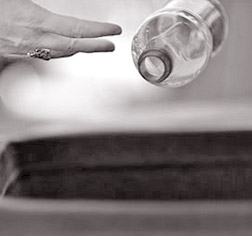|
Tackling the problem posed by increasing plastic and
polythene:
Scheme to overcome Post Consumer Plastic Waste
By Dhaneshi Yatawara
 |
Director
General
Dr. Saranga Alahapperuma |
 |
| Project
Director Bandula Sarath Kumara |
15m lunch sheets, 20m shopping bags are dumped each day
20 million yoghurt cups and one million sachet packets dumped per
month
500,000 metric tons of virgin plastic are imported to the country -
70 percent used locally
Globally every ten years plastic consumption increases by three times
Did you know that as Sri Lankans we contribute to collect 15 million
lunch sheets on average per day. And we dump polythene bags that we
carry stuff - carrier bags -, nearly 20 million of them each day. These
statistics were revealed by a study done jointly by the University of
Kelaniya and the Central Environment Authority nearly a year ago. Every
time one Sri Lankan goes shopping, results in ending up with many
polythene bags - either grocery ones or carrier bags - and we hardly
recycle or at least reuse. The research was conducted by both parties
for five months in five districts.
Post Consumer Plastic Waste has created problems in all communities
in massive proportions. Though numerous tactics came up during the past
few years to recycle this menace in a more effective way, the problem
remains the same as well as the improper dispose to the environment.
|

A washing plant installed by the CEA |
Sri Lanka Imports annually a considerable amount of plastic raw
materials and finished products and a major portion of them ends up as
Post Consumer Plastic Waste causing severe environmental problems. The
Project was initially funded by 1 percent CESS imposed on imports of all
Plastic raw materials and finished goods and thereafter it was increased
up to 10 percent on reducing prices of virgin plastics due to a fuel
price drop in 2009.
This project is being monitored by Plastic Partnership Committee the
members of which were appointed from Private Sector and Government
Institutions.
Under the National Post Consumer Plastic Waste Management Project,
the Central Environment Authority over the years has come up with
different programs to address this non degrading problem. The National
Post Consumer Plastics Waste Management Project will focus on three main
programs - i.e. Development of regional plastic waste collection system,
development of plastic recycling network and awareness and promotional
campaign.
The project, implemented in mid 2007, also focus on the behavioural
change necessary among the Sri Lankan consumers to ensure proper
disposal of plastic waste and to put in place the necessary logistics to
enable the collection and recycling. A considerable portion of the post
consumer plastic consist of lunch sheets, grocery bags and carrier bags.
"Everyday each family throws out 5 - 6 shopping bags per day. And mind
you we have approximately 4.2 million families in the country," said
Director of the National Post Consumer Plastic Waste Management Project
Bandula Sarath Kumara.
In recycling these plastic and polythene the biggest problem is its
contamination with dirt - in the case of lunch sheets those are thrown
away with remaining food which gets spoiled over time. These
contaminations need to be removed, thus these post consumer plastic
waste was washed before recycling.
To expedite this process and to match with the rate at which such
waste is created, the CEA established a new system to wash the waste in
noted recycler plants.
"Earlier individual people washed these lunch sheets in rivers and
open waterways creating a lot of environment damage. And the rate was
very slow too,"said Kumara.
The washing plants are set up in Western province - one for each
district. Heavy polythene is easily accepted by the recyclers as those
are easy to recycle and very less contamination. Yet when it came to
light polythene like lunch sheets, shopping and carrier bags had a
problem in being recycled.
 Before the washing plants were set up recyclers have been reluctant
to use such as waste as a washing plant would be significantly costly
for them if they were to set up on their own, said Director General of
the CEA, Dr. Saranga Alahapperuma. "With the set up of these washing
plants in one province we were able to increase the recycling amount by
10 percent," according to DG Alahapperuma. Before the washing plants were set up recyclers have been reluctant
to use such as waste as a washing plant would be significantly costly
for them if they were to set up on their own, said Director General of
the CEA, Dr. Saranga Alahapperuma. "With the set up of these washing
plants in one province we were able to increase the recycling amount by
10 percent," according to DG Alahapperuma.
According to the statistics available with the CEA, annually Sri
Lanka is importing 500,000 metric tons of virgin plastic out of which
only 30 percent leaves the country in different types of exported goods.
The other 70 percent remains in the island.
Plastics are especially troublesome, as different types of plastic
require different processing to be reformulated and re-used as raw
material. "With plastic and polythene we cannot use other strategies as
burning or burying as both causes heavy pollution. So constantly we have
to come up with different solutions to solve the waste problem created
with the use of plastic and polythene," said Alahapperuma. In Sri Lanka
we dump one million sachet packets - be it with sauce, jam or shampoo.
Per month we dump 20 million yoghurt cups.
Th Colombo municipal Council collects 700 tons of garbage on average
per day and 6 percent of this is polythene and plastic waste. "According
to world surveys by every ten years the plastic consumption increases by
three times. This poses a great challenge as well as a threat to the
environment. While promoting behavioral changes in individuals to omit
or minimise using plastic and polythene use we have to find more
innovative methods to recycle this post consumer plastic and polythene
waste," said Dr. Alahapperuma.
*************
[Understanding levels of recycling]
Numbers ranging from 1 to 7 and surrounded by a triangle of arrows
was designed by the Society of the Plastics Industry (SPI) in 1988 to
allow consumers and recyclers to differentiate types of plastics while
providing a uniform coding system for manufacturers.
1) Easy Plastics to Recycle - number 1
The easiest and most common plastics to recycle are made of
polyethylene terephthalate (PETE) and are assigned the number 1. Once it
has been processed by a recycling facility, PETE can become fiberfill
for winter coats, sleeping bags and life jackets. It can also be used to
make bean bags, rope, car bumpers, tennis ball felt, combs, cassette
tapes, sails for boats, furniture and, of course, other plastic bottles.
Found in: Soft drink, water and beer bottles; mouthwash bottles;
peanut butter containers; salad dressing and vegetable oil containers;
ovenable food trays.
2) Number 2 -
Number 2 is reserved for high-density polyethylene (HDPE) plastics.
These include heavier containers. These are widely accepted at recycling
centres. HDPE is a versatile plastic with many uses, especially for
packaging. It carries low risk of leaching and is readily recyclable
into many goods.
Found in: Milk jugs, juice bottles; bleach, detergent and household
cleaner bottles; shampoo bottles; some trash and shopping bags; motor
oil bottles; butter and yoghurt tubs; cereal box liners.
Number 2 is often recycled into toys, piping, plastic lumber and
rope.
3) Plastics Less Commonly Recycled - Number 3
This includes Polyvinyl chloride (PVC), commonly used in plastic
pipes, shower curtains, medical tubing, vinyl dashboards, and even some
baby bottle nipples. These are rarely recycled; accepted by some plastic
lumber makers. Once recycled can be conerted in to Decks, paneling,
mudflaps, roadway gutters, flooring, cables, speed bumps, mats.
PVC is tough and weathers well, so it is commonly used for piping,
siding and similar applications. PVC contains chlorine, so its
manufacture can release highly dangerous dioxins. If you must cook with
PVC, don't let the plastic touch food. Also never burn PVC, because it
releases toxins.
Found in: Window cleaner and detergent bottles, shampoo bottles,
cooking oil bottles, clear food packaging, wire jacketing, medical
equipment, siding, windows, piping
4) Number 4 - The low density polythenes (low density polyethylene -
LDPE)
Number 4s include wrapping films, grocery and sandwich bags, and
other containers made of low-density polyethylene. Once recycled can be
used in trash can liners and cans, compost bins, shipping envelopes,
paneling, lumber, landscaping ties, floor tile. LDPE is a flexible
plastic with many applications.
Found in: Squeezable bottles; bread, frozen food, dry cleaning and
shopping bags; tote bags; clothing; furniture; carpet .
5) Number 5 - PP or Polypropylene
Polypropylene has a high melting point, and so is often chosen for
containers that must accept hot liquid. It is gradually becoming more
accepted by recyclers. When recycled can be used in signal lights,
battery cables, brooms, brushes, auto battery cases, ice scrapers,
landscape borders, bicycle racks, rakes, bins, pallets, trays.
Found in: Some yoghurt containers, syrup bottles, ketchup bottles,
caps, straws, medicine bottles
6) Number 6 Plastics - polystyrene (Styrofoam)
The Number 6 was long on environmentalists' hit lists for dispersing
widely across the landscape, and for being notoriously difficult to
recycle.
Polystyrene can be made into rigid or foam products - in the latter
case it is popularly known as the trademark Styrofoam. Evidence suggests
polystyrene can leach potential toxins into foods. Most places still
don't accept it, though it is gradually gaining traction.
Found in: Disposable plates and cups, meat trays, egg cartons,
carry-out containers, aspirin bottles, compact disc cases
Recycled into: Insulation, light switch plates, egg cartons, vents,
rulers, foam packing, carry-out containers
7) Number 7 Plastics - Hardest Plastics
Are crafted from various combinations of the above mentioned plastics
or from unique plastic formulations not commonly used. A wide variety of
plastic resins that don't fit into the previous categories are lumped
into number 7. The controversial Polycarbonate falls in to number 7. A
few are even made from plants (polyactide) and can be turned in to
compost.
When recycled can be used in manufacturing plastic lumber and
custom-made products.
Found in: Three- and five-gallon water bottles, 'bullet-proof'
materials, sunglasses, DVDs, iPod and computer cases, signs and
displays, certain food containers, nylon. |


